There are moments in life when a recipe becomes more than just instructions, it becomes a treasured memory of someone special.
This Creamy Chicken Pastel recipe was lovingly taught to me by my best friend, Joanne, who lost her battle with cancer. Every time I prepare this dish, I'm transported back to her tiny kitchen in Orion, Bataan, where she showed me how to get that perfect creamy sauce that Filipino families love.
"Mas maraming cream, mas masaya," (More cream, happier) she would always say with a laugh, teaching me that sometimes the best recipes come from being generous with both ingredients and love.
In all my years of cooking Filipino food, I've never found a dish that brings together the comfort of home and the elegance of special occasions quite like this one. It's the kind of recipe that makes ordinary weeknight dinners feel like a celebration and makes actual celebrations feel even more special.
This is Joanne's legacy in my kitchen, and now I'm sharing it with you.
Jump to:
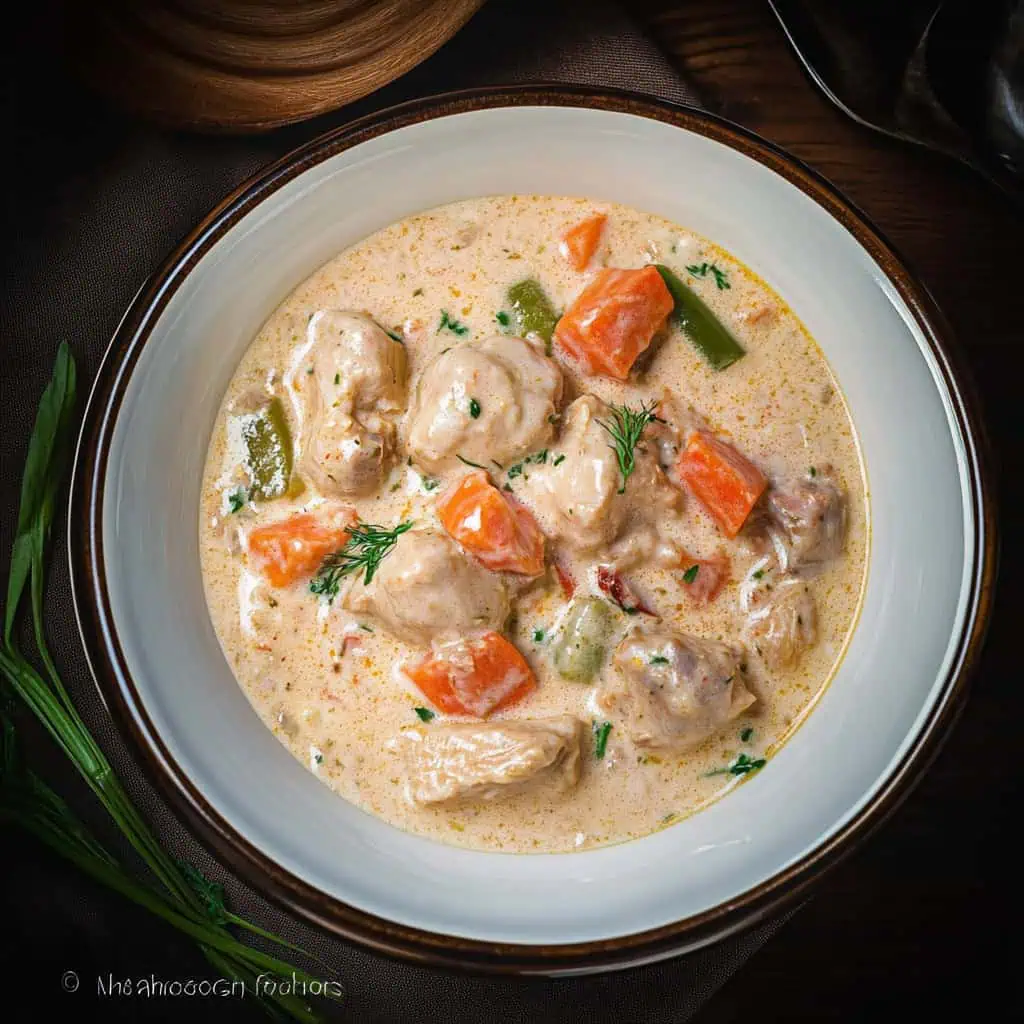
Why You'll Love This Recipe
- Extra creamy sauce that perfectly coats every ingredient
- No complicated pie crust needed - just pure comfort food goodness
- Made with easily accessible ingredients
- Versatile recipe that can be customized to your taste
- Perfect make-ahead dish for special occasions
- Combines Spanish and Filipino flavors in one elegant dish
Ingredients
This recipe brings together a thoughtfully selected blend of ingredients that create the perfect Filipino Chicken Pastel. The chicken provides a tender, protein-rich base while the marinade of soy sauce and citrus tenderizes the meat and adds depth.
Chorizo de Bilbao contributes a distinctive smoky flavor that's quintessentially Filipino-Spanish, while hotdogs add a touch of sweetness and that beloved Filipino twist. The all-purpose cream creates the luxurious, velvety sauce that defines this dish, while the colorful mix of vegetables (potatoes, carrots, bell peppers, and mushrooms) adds nutrition, texture, and visual appeal.
Each ingredient serves a purpose, from the aromatics like garlic and onion that build the flavor foundation to the Knorr cube that enhances the savory notes throughout. Together, they create a harmonious blend of flavors, textures, and colors that makes this dish a Filipino classic.
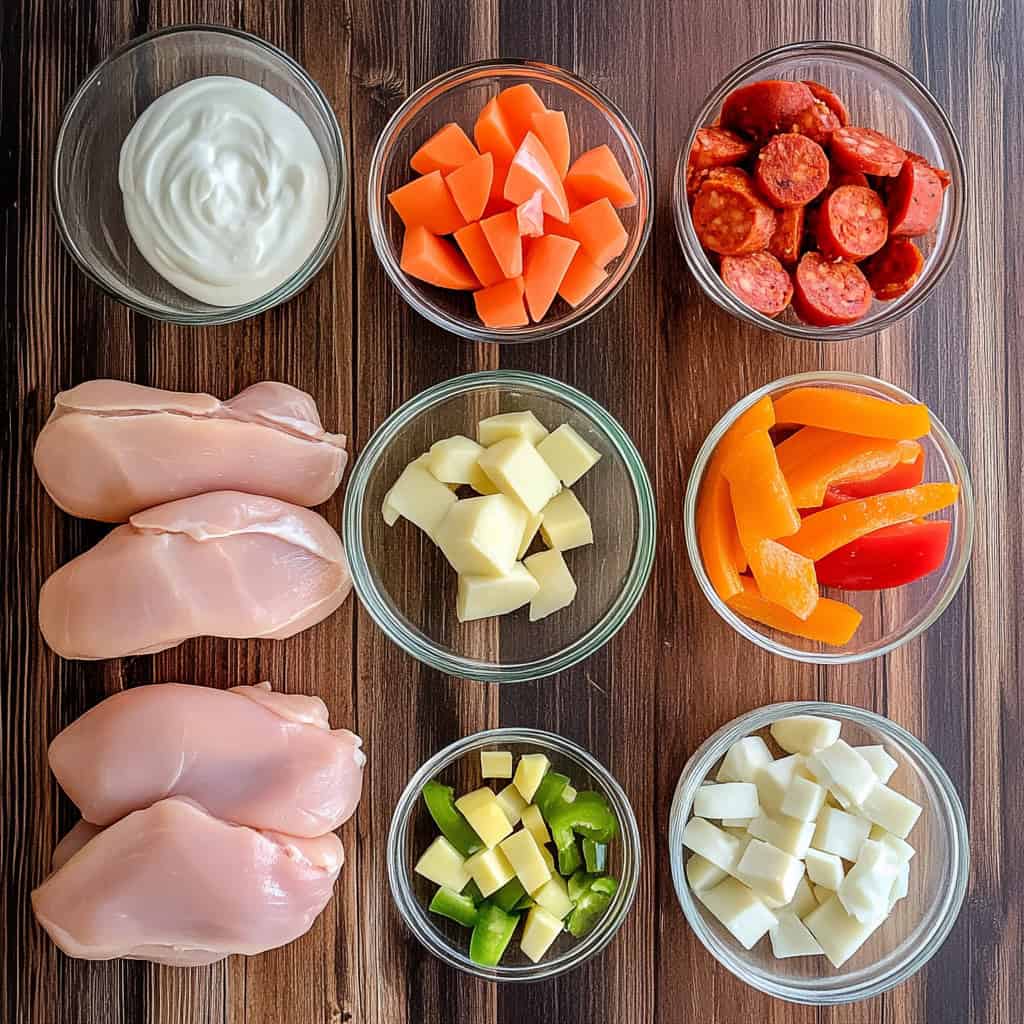
- 2 lbs chicken breast, cubed
- ¼ cup soy sauce
- 1 piece lime or 3 pieces calamansi, juiced
- 1 piece Knorr Chicken Cube
- 1 piece Chorizo de Bilbao, sliced
- 4 pieces hotdogs, sliced diagonally
- 15 ounces all-purpose cream
- 1 medium onion, chopped
- 4 cloves garlic, minced
- ¾ cup water
- 3 tablespoons cooking oil
- 1 medium potato, cubed
- 1 medium carrot, sliced
- 1 red bell pepper, sliced
- 1 green bell pepper, sliced
- ¾ cup button mushrooms, sliced
- Salt, to taste
- Ground black pepper, to taste
Equipment
- Large heavy-bottom pot or Dutch oven: Provides even heat distribution to prevent cream from curdling and ensures thorough cooking
- Sharp knife and cutting board: For precisely cutting ingredients to ensure even cooking
- Measuring cups and spoons: For accurate ingredient measurements
- Wooden spoon or silicone spatula: For gentle stirring without scratching the pot
- Medium-sized mixing bowl: For marinating the chicken
- Kitchen timer: To track cooking times for perfectly tender chicken
- Food thermometer: To ensure chicken reaches safe internal temperature (165°F/75°C)
- Airtight containers: For storing leftovers
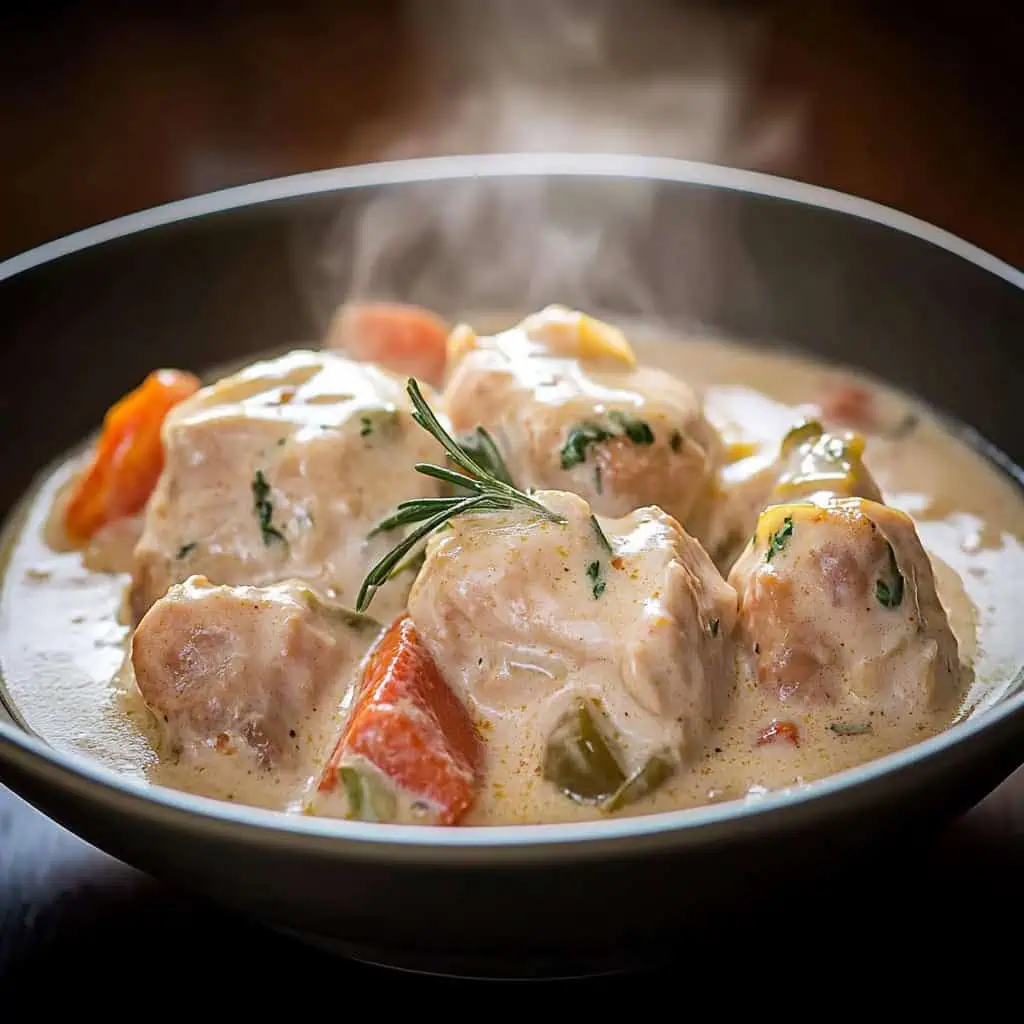
How To Make
- Marinate the chicken: In a bowl, combine cubed chicken breast with soy sauce and lime or calamansi juice. Mix well and refrigerate for at least 30 minutes or up to 4 hours.
- Prepare the base: Heat cooking oil in your pot over medium heat. Add chopped onion and sauté until translucent (about 3 minutes). Add minced garlic and cook until fragrant (about 1 minute).
- Build flavors: Add sliced Chorizo de Bilbao and cook until the oils release (2-3 minutes). Add the marinated chicken and sauté until light brown (5-7 minutes).
- Create the broth: Pour in water and bring to a boil. Add the Knorr Chicken Cube, cover, and simmer for 20 minutes or until chicken reaches an internal temperature of 165°F/75°C.
- Add proteins and root vegetables: Add sliced hotdogs and cook until the liquid reduces by half. Add cubed potato and sliced carrot. Pour in all-purpose cream, cover, and cook for 8 minutes.
- Finish with tender vegetables: Add sliced mushrooms and bell peppers. Cook for a final 3 minutes.
- Season and rest: Adjust flavor with salt and black pepper to taste. Let the dish rest for 5-10 minutes before serving to allow the sauce to thicken.
- Serve: Enjoy hot with steaming white rice or crusty pan de sal.

Tips from Lola's Kitchen
- Flavor boost: Use bone-in chicken thighs for richer flavor, removing bones before serving
- Marinade magic: Extend marination to overnight for deeper flavor penetration
- Depth enhancer: Add a splash of dry white wine while sautéing the vegetables
- Garlic technique: Toast garlic until golden brown for a nuttier flavor profile
- Cream care: Always stir cream gently and maintain medium-low heat to prevent curdling
- Final touch: Allow the dish to rest covered for 5-10 minutes before serving – this lets flavors meld and sauce thicken naturally
Substitutions
- Chorizo de Bilbao: Spanish chorizo, Chinese sausage, or even bacon in a pinch
- All-purpose cream: Heavy cream for extra richness or evaporated milk for a lighter version
- Lime: Lemon or any citrus fruit you have available
- Button mushrooms: Shiitake or oyster mushrooms for more complex flavor
- Chicken breast: Boneless chicken thighs for juicier results
- Knorr cube: Any chicken bouillon or homemade chicken stock reduced by half
Troubleshooting
- Sauce too thin: Simmer uncovered for a few extra minutes to reduce and concentrate flavors
- Sauce too thick: Gradually add warm chicken broth or water, one tablespoon at a time
- Curdled cream: Lower heat immediately, add a splash of room-temperature cream, and whisk gently
- Tough chicken: Cut chicken into more uniform pieces and monitor internal temperature carefully
- Vegetables unevenly cooked: Add denser vegetables earlier and more delicate ones later in the cooking process
Storage & Reheating
- Refrigeration: Store in an airtight container for up to 3 days
- Freezing: For best results, freeze the base without cream for up to 2 months, then add fresh cream when reheating
- Reheating on stovetop: Warm over low heat, stirring occasionally to prevent scorching
- Reheating in microwave: Heat on medium power for 2-3 minutes, stirring halfway through
- Revitalizing: Add a tablespoon of fresh cream when reheating to restore the silky texture
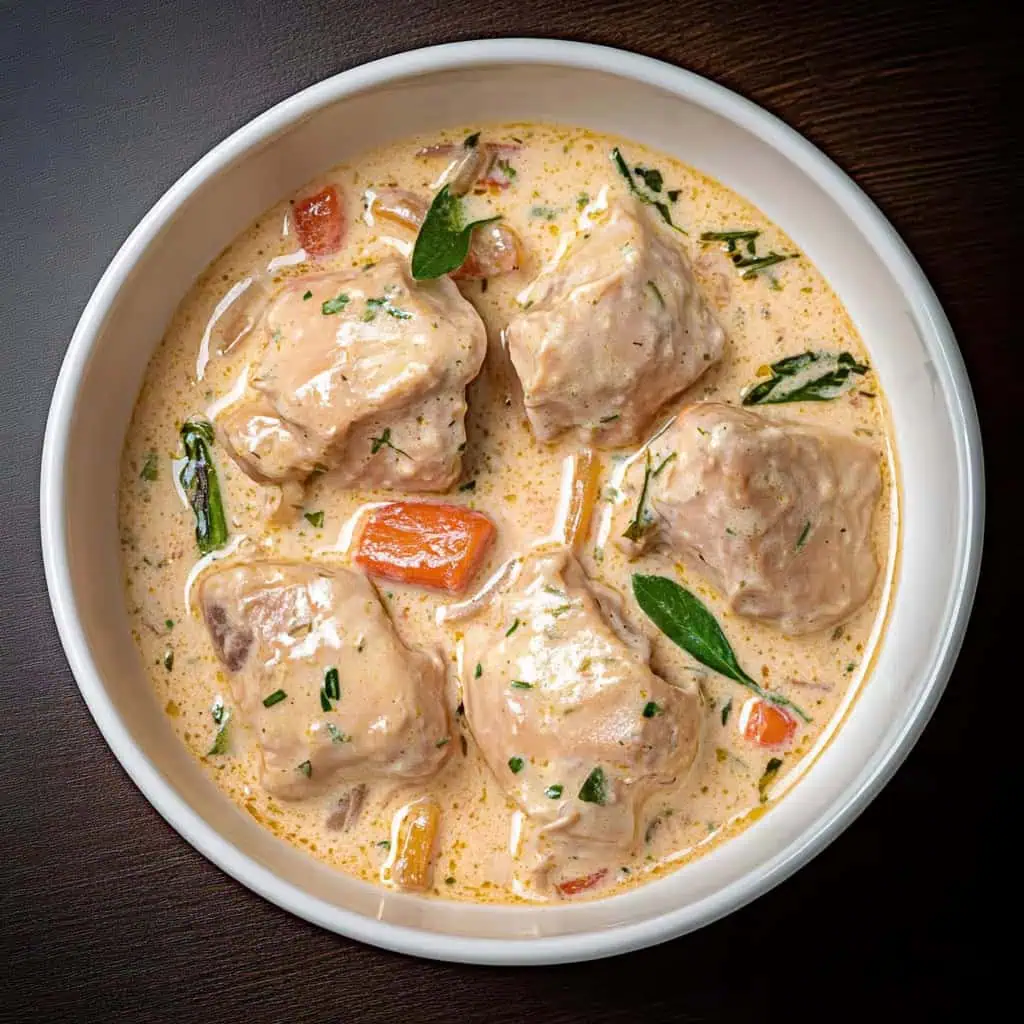
FAQ
Can I make this ahead for a party?
Yes, prepare up to 24 hours ahead and reheat gently. The flavors actually improve with time.
Why is my sauce splitting?
This happens when heat is too high. Always cook on medium-low when adding cream and avoid boiling once cream is added.
Can I use chicken fillets instead of cubed chicken?
Absolutely. Simply adjust cooking time to approximately 15 minutes for fillets.
Is this recipe freezer-friendly?
It's best to freeze without the cream and add fresh cream when reheating for the smoothest texture.
Can I add different vegetables?
Certainly! Green peas, corn, or asparagus work wonderfully – add delicate vegetables in the final few minutes of cooking.
Can I make this into a proper pot pie?
Yes! Transfer the finished filling to a baking dish, top with puff pastry, brush with egg wash, and bake at 375°F until golden (about 20-25 minutes).
What makes this dish uniquely Filipino?
The combination of Spanish influence (chorizo) with Filipino adaptations (hotdogs) and the preference for serving with rice instead of encased in pastry crust.
Can I make a lower-calorie version?
Use evaporated low-fat milk instead of cream, reduce oil to 1 tablespoon, and increase vegetables while decreasing meat portions.
Related
Looking for other recipes like this? Try these:
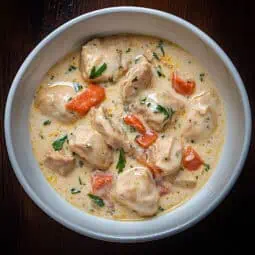
Creamy Chicken Pastel (Chicken Pot Pie Filipino Style)
Equipment
- Large heavy-bottom pot or Dutch oven for even heat distribution
- Sharp knife and cutting board for precise ingredient prep
- Measuring cups and spoons for precise measurement
- Wooden spoon or spatula for stirring without scratching the pot
- Medium-sized mixing bowl for marinating
- Kitchen Timer
- Food thermometer to ensure chicken is properly cooked
- Airtight containers for storage
Ingredients
For the Chicken Marinade (Para sa Pagpapaalat ng Manok)
- 2 lbs chicken breast cubed (hiniwa ng parisukat)
- ¼ cup soy sauce toyo
- 1 piece lime or 3 pieces calamansi
For the Stew Base (Para sa Sarsa)
- 1 piece Knorr Chicken Cube
- 1 piece Chorizo de Bilbao sliced (hiniwang chorizo)
- 4 pieces hotdogs sliced diagonally (hiniwang hotdog)
- 15 ounces all-purpose cream
- 1 piece onion chopped (sibuyas)
- 4 cloves garlic minced (bawang)
- ¾ cup water tubig
- 3 tablespoons cooking oil mantika
Vegetables (Gulay)
- 1 piece potato cubed (patatas)
- 1 piece carrot sliced
- 1 piece red bell pepper sliced (pulang siling pangsigang)
- 1 piece green bell pepper sliced (berdeng siling pangsigang)
- ¾ cup button mushroom sliced (kabute)
Seasonings (Pampalasa)
- Salt asin to taste
- Ground black pepper pamintang durog to taste
Instructions
- Start by marinating the chicken. In a bowl, combine 2 lbs cubed chicken breast with ¼ cup soy sauce (toyo) and juice from 1 piece lime or 3 pieces calamansi. Mix well and refrigerate for at least 30 minutes or up to 4 hours.
- Heat 3 tablespoons cooking oil (mantika) in a large heavy-bottom pot over medium heat (180°C/350°F). Add 1 chopped onion (sibuyas) and sauté until translucent, about 3 minutes. Add 4 cloves minced garlic (bawang) and cook until fragrant, about 1 minute.
- Add the sliced Chorizo de Bilbao (hiniwang chorizo) and cook until the oils release, about 2-3 minutes. Add the marinated chicken to the pot and sauté until light brown, about 5-7 minutes.
- Pour in ¾ cup water (tubig) and bring to a boil. Add 1 piece Knorr Chicken Cube (pancalang manok), cover, and simmer for 20 minutes or until chicken reaches an internal temperature of 75°C/165°F.
- Add the sliced hotdogs (hiniwang hotdog) and cook until the liquid reduces by half. Add the cubed potato (patatas) and sliced carrot. Pour in 15 ounces all-purpose cream and cover, cooking for 8 minutes.
- Add the sliced button mushrooms (kabute), red bell pepper, and green bell pepper. Cook for a final 3 minutes.
- Season with salt (asin) and ground black pepper (pamintang durog) to taste. Let the dish rest for 5-10 minutes before serving to allow the sauce to thicken.
- Serve hot with steaming white rice (kanin) or crusty pan de sal. For best results, maintain medium-low heat (160°C/320°F) when working with the cream to prevent curdling.
Tips from Lola's Kitchen
- Use bone-in chicken for extra flavor, just remove bones before serving
- Marinate chicken overnight for maximum flavor
- Add a splash of white wine while sautéing for extra depth
- Toast garlic until golden brown for nuttier flavor
- Stir cream gently to prevent curdling
- Let rest for 5-10 minutes before serving to allow sauce to thicken
Nutrition
The Story Behind Filipino Chicken Pastel
When Spanish colonizers arrived in the Philippines in the 16th century, they brought with them their beloved pastel de pollo - a savory meat pie that would eventually transform into the Filipino Chicken Pastel we know today. Unlike its Spanish ancestor, which always featured a flaky crust, our local version evolved to celebrate the creamy filling that Filipinos fell in love with, often served with rice rather than enclosed in pastry.
In the grand mansions of Intramuros during the Spanish colonial period, this dish was a mainstay at elegant dinner parties, where its rich combination of chicken, chorizo de bilbao, and European-inspired cream sauce impressed distinguished guests. Over generations, Filipino cooks adapted the recipe, incorporating local ingredients and preferences. The addition of hotdogs - a distinctly Filipino touch - speaks to our culture's talent for making foreign dishes our own.
What makes Filipino Chicken Pastel truly special is how it bridges social classes. While its origins lie in aristocratic Spanish cuisine, it has become a cherished dish in Filipino households across all walks of life. From simple family dinners to elaborate fiestas, this creamy chicken dish represents the Filipino talent for adaptation and our love for bringing people together through food.
Today's version of Chicken Pastel reflects our practical nature - many home cooks skip the labor-intensive crust but keep the luxuriously creamy filling that makes this dish irresistible. The combination of tender chicken, smoky chorizo, colorful vegetables, and that signature velvety sauce continues to make it a favorite at Christmas gatherings, town fiestas, and family celebrations. It's a testament to how Filipino cuisine expertly weaves foreign influences into something uniquely and deliciously our own.
This beloved dish shows how Filipino food isn't just about sustenance - it's about history, culture, and the way we've taken foreign influences and transformed them into something distinctly ours. Whether served in a clay pot in Pampanga, a fancy casserole in Makati, or a humble serving bowl in a neighborhood carinderia, Chicken Pastel remains a delicious symbol of our culinary heritage.
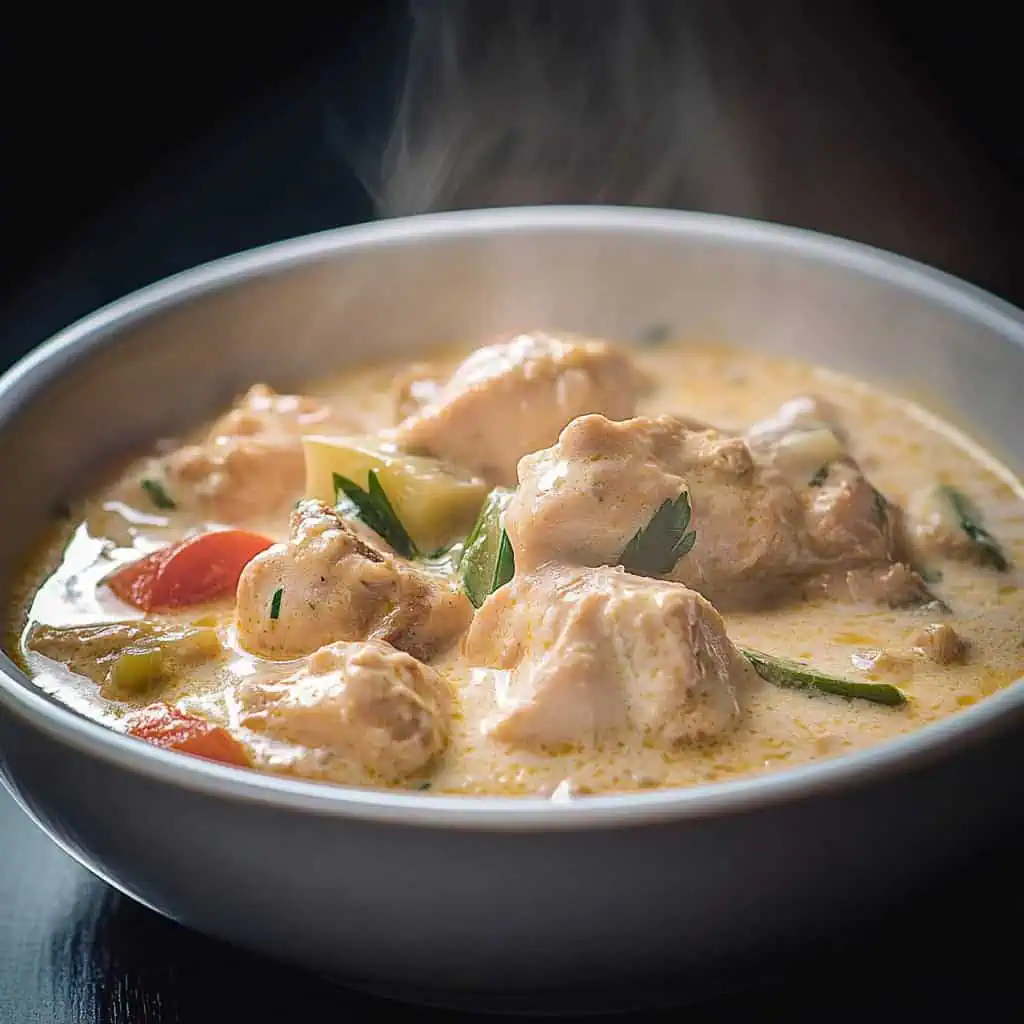





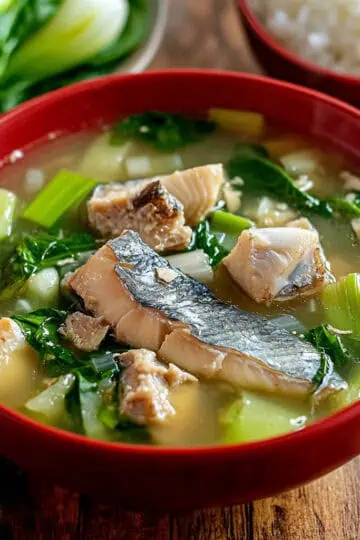
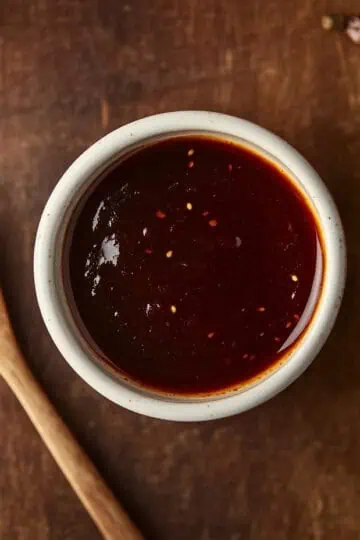
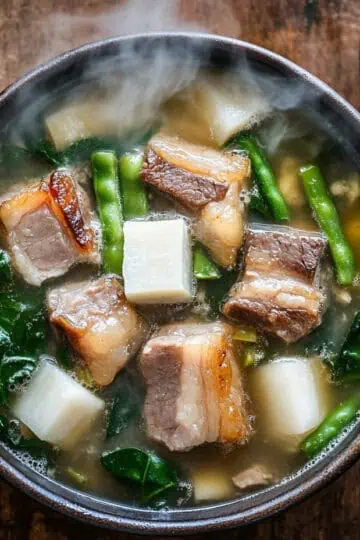
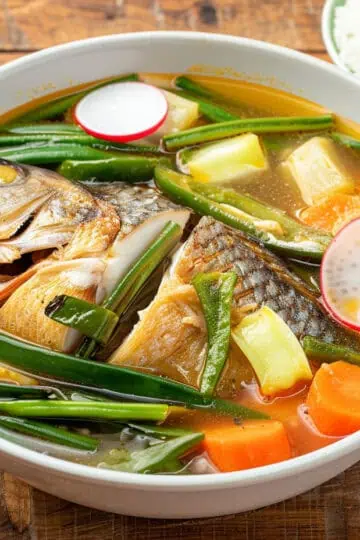
Comments
No Comments